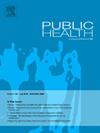长COVID编码诊断的易感因素
IF 3.9
3区 医学
Q1 PUBLIC, ENVIRONMENTAL & OCCUPATIONAL HEALTH
引用次数: 0
摘要
目的长型COVID的特征是在初次感染COVID-19病毒后出现一系列持续症状。本研究的主要重点是研究在至少一次确诊的COVID-19检测呈阳性后,被诊断为长冠状病毒的人的特征与未被诊断为长冠状病毒的匹配个体的特征有何不同。研究设计一项回顾性观察队列研究,使用从人口数据库中收集的285万人的数据,收集时间为2020年1月1日至2024年1月31日。方法主要结局为初级保健编码诊断,或在急性COVID-19感染后转诊到Long COVID诊所治疗。26,626人被诊断为长冠状病毒,并且至少有一次之前记录的COVID-19阳性检测。这些人按年龄和性别与133,165人(即5对照1病例的近似比例)相匹配,他们至少有一次之前记录的COVID-19阳性检测结果,但没有记录的长COVID诊断。还分析了死亡率与先前确诊的COVID-19急性感染的关系。结果诊断为长冠肺炎的患者中2、3、4、5种及以上合并症的比例高于1种或无合并症的患者。与白人相比,黑人/黑人英国种族(+ 28%)和混合种族(+ 37%)都与长COVID诊断的可能性更高相关。那些处于最不利地位的五分之一群体(以汤森指数衡量)患长COVID的可能性是最有利的五分之一群体的两倍多。每出现一种共病,长冠状病毒感染的风险增加5.7%,并受COVID-19疫苗接种次数的调节。每增加一名新冠肺炎确诊阳性患者,长冠肺炎的风险就会增加一倍。当考虑汤森五分位数时,BMI没有影响。最后,我们分析了COVID-19感染后的死亡率。女性性行为与较低的死亡风险相关。汤森五分位数测量的弱势群体更有可能死亡。在最贫困的五分之一中,这种风险几乎是最贫困五分之一的两倍。在对年龄和性别匹配的个体进行的全市范围的研究中,我们确定,处于社会弱势地位、黑人/黑人英国人或混合种族增加了患长COVID的风险。当考虑汤森五分位数时,BMI没有影响。这些发现可以为未来的公共卫生信息和公共卫生干预提供信息,无论是与长期COVID还是未来的大流行防范有关。本文章由计算机程序翻译,如有差异,请以英文原文为准。
The predisposing factors to having a coded diagnosis of Long COVID
Objectives
Long COVID is characterized by a constellation of persistent symptoms following an initial infection with COVID-19 virus. The primary focus of this study was to investigate how the characteristics of people diagnosed with Long COVID differed from those of matched individuals who did not have a diagnosis of Long COVID, after at least one confirmed positive COVID-19 test.
Study design
A retrospective observational cohort study was performed using data collected for the time period, January 1, 2020 to January 31, 2024 from a population database of 2.85 million people.
Methods
The primary outcome was a primary care coded diagnosis, or referral for treatment of Long COVID following an acute COVID-19 infection, to a Long COVID clinic. Twenty six thousand, six hundred and twenty six (26,626) individuals were identified with a diagnosis of Long COVID and at least one previous recorded COVID-19 positive test. These were matched by age and sex with 133,165 individuals (i.e. an approximate ratio of 5 controls to one case) with at least one previous recorded COVID-19 positive test but no recorded diagnosis of Long COVID. Mortality rate was also analysed in relation to having a previous confirmed acute COVID-19 infection.
Results
There was a higher proportion of people with 2, 3, 4 and 5 or more comorbidities in the diagnosed Long COVID group compared to those with one or no comorbidity. Black/ Black British ethnicity (+28 %) and Mixed ethnicity (+37 %) were both associated with a higher likelihood of a Long COVID diagnosis when compared to White ethnicity. Those in the most disadvantaged quintile (as measured by Townsend index) were more than twice as likely to have Long COVID than the most advantaged quintile. The risk of Long COVID increased by 5.7 % per each comorbidity, with modulation by the number of COVID-19 vaccinations. The risk of Long COVID doubled for every additional confirmed positive COVID-19 test. BMI did not have an effect when account was taken of Townsend quintile.
Lastly, we analysed mortality rates following a COVID-19 infection. Female sex was associated with a lower risk of death. More disadvantaged individuals as measured by Townsend quintile were more likely to have died. This risk was nearly doubled for the most deprived quintile compared to least deprived quintile.
Conclusions
In this city region wide study with individuals matched for age and sex, we have determined that being in a socially disadvantaged situation and being Black/Black British or of Mixed ethnicity increased the risk of developing Long COVID. BMI did not have an effect when account was taken of Townsend quintile. These findings can inform public health messages and public health interventions going forward, whether in relation to Long COVID or future pandemic preparedness.
求助全文
通过发布文献求助,成功后即可免费获取论文全文。
去求助
来源期刊

Public Health
医学-公共卫生、环境卫生与职业卫生
CiteScore
7.60
自引率
0.00%
发文量
280
审稿时长
37 days
期刊介绍:
Public Health is an international, multidisciplinary peer-reviewed journal. It publishes original papers, reviews and short reports on all aspects of the science, philosophy, and practice of public health.
 求助内容:
求助内容: 应助结果提醒方式:
应助结果提醒方式:


